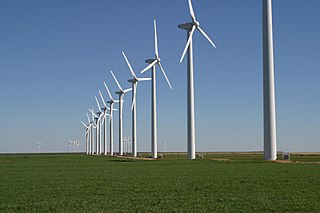A rolling blackout, also referred to as rota or rotational load shedding, rota disconnection, feeder rotation, or a rotating outage, is an intentionally engineered electrical power shutdown in which electricity delivery is stopped for non-overlapping periods of time over different parts of the distribution region. Rolling blackouts are a last-resort measure used by an electric utility company to avoid a total blackout of the power system.

The Electric Reliability Council of Texas, Inc. (ERCOT) is an American organization that operates Texas's electrical grid, the Texas Interconnection, which supplies power to more than 25 million Texas customers and represents 90 percent of the state's electric load. ERCOT is the first independent system operator (ISO) in the United States. ERCOT works with the Texas Reliability Entity (TRE), one of six regional entities within the North American Electric Reliability Corporation (NERC) that coordinate to improve reliability of the bulk power grid.

Austin Energy is a publicly owned utility providing electrical power to the city of Austin, Texas and surrounding areas. Established in 1895, the utility is a department of the City of Austin and returns its profits to the city's general fund to finance other city services. Austin Energy is the United States' 7th largest public utility, serving more than 500,000 customers and more than one million residents within a service area of approximately 437 square miles (1,130 km2), including Austin, Travis County and a small portion of Williamson County.
The Texas electricity market is deregulated, meaning that there is competition in the generation and distribution of electricity. Power generators in the Texas Interconnection, managed by the Electric Reliability Council of Texas, participate in an energy-only electricity market and are compensated only for the electricity they produce. The wholesale generation market was deregulated in 1995 and the distribution market in 1999, with Texas Senate Bill 7. This replaced the prior system in which power was generated and consumed locally by the same utility with one in which retail providers contracted with generators across the state.

The Texas Interconnection is an alternating current (AC) power grid – a wide area synchronous grid – that covers most of the state of Texas. The grid is managed by the Electric Reliability Council of Texas (ERCOT).

Southwest Power Pool (SPP) manages the electric grid and wholesale power market for the central United States. As a regional transmission organization, the nonprofit corporation is mandated by the Federal Energy Regulatory Commission to ensure reliable supplies of power, adequate transmission infrastructure and competitive wholesale electricity prices. Southwest Power Pool and its member companies coordinate the flow of electricity across approximately 60,000 miles of high-voltage transmission lines spanning 14 states. The company is headquartered in Little Rock, Arkansas.

Wind power is a branch of the energy industry that has expanded quickly in the United States over the last several years. From January through December 2022, 434.8 terawatt-hours were generated by wind power, or 10.25% of electricity in the United States. The average wind turbine generates enough electricity in 46 minutes to power the average American home for one month. In 2019, wind power surpassed hydroelectric power as the largest renewable energy source in the U.S.

A black start is the process of restoring an electric power station or a part of an electric grid to operation without relying on the external electric power transmission network to recover from a total or partial shutdown.

Wind power in Texas, a portion of total energy in Texas, consists of over 150 wind farms, which together have a total nameplate capacity of over 30,000 MW. If Texas were a country, it would rank fifth in the world: The installed wind capacity in Texas exceeds installed wind capacity in all countries but China, the United States, Germany and India. Texas produces the most wind power of any U.S. state. According to the Electric Reliability Council of Texas (ERCOT), wind power accounted for at least 15.7% of the electricity generated in Texas during 2017, as wind was 17.4% of electricity generated in ERCOT, which manages 90% of Texas's power. ERCOT set a new wind output record of nearly 19.7 GW at 7:19 pm Central Standard Time on Monday, January 21, 2019.

An electrical grid is an interconnected network for electricity delivery from producers to consumers. Electrical grids vary in size and can cover whole countries or continents. It consists of:

At the end of 2016, the installed capacity for wind power in Minnesota was 3,500 megawatts (MW). Wind power generated nearly 18 percent of Minnesota’s electricity in 2016, ranking sixth in the nation for wind energy as a share of total electricity generation.
There is a large array of stakeholders that provide services through electricity generation, transmission, distribution and marketing for industrial, commercial, public and residential customers in the United States. It also includes many public institutions that regulate the sector. In 1996, there were 3,195 electric utilities in the United States, of which fewer than 1,000 were engaged in power generation. This leaves a large number of mostly smaller utilities engaged only in power distribution. There were also 65 power marketers. Of all utilities, 2,020 were publicly owned, 932 were rural electric cooperatives, and 243 were investor-owned utilities. The electricity transmission network is controlled by Independent System Operators or Regional Transmission Organizations, which are not-for-profit organizations that are obliged to provide indiscriminate access to various suppliers to promote competition.
South Australia is a leader in utility-scale renewable energy generation, and also produces gas and uranium for electricity generation. Gas production is mostly concentrated in the Cooper Basin in the state's north-east. Gas is delivered from these fields by pipeline to users interstate and to Port Adelaide where it fuels three separate gas-fired power plants. Uranium is also mined in South Australia, though nuclear power generation is prohibited nationally. The Olympic Dam mine is the world's single largest known deposit of uranium and represents 30% of the world's total uranium resource. Many utility-scale wind farms and solar farms have been commissioned during the 21st century and geology with potential for geothermal energy has also been identified but is yet to be developed.

Energy in California is a major area of the economy of California. California is the state with the largest population and the largest economy in the United States. It is second in energy consumption after Texas. As of 2018, per capita consumption was the fourth-lowest in the United States partially because of the mild climate and energy efficiency programs.

The U.S. State of Oklahoma has high potential capacity for wind power in the western half of the state. In 2021, Oklahoma's installed wind generation capacity was almost 10,500 megawatts, supplying over 40% of the state's generated electricity and 85% of Oklahoma's total generating capacity from all renewable resources.

The California Independent System Operator (CAISO) is a non-profit Independent System Operator (ISO) serving California. It oversees the operation of California's bulk electric power system, transmission lines, and electricity market generated and transmitted by its member utilities. CAISO is one of the largest ISOs in the world, delivering 300 million megawatt-hours of electricity each year and managing about 80% of California's electric flow.
Lubbock Power and Light (LP&L) is third largest municipal electric utility in Texas. LP&L serves more than 101,000 electric meters and owns and maintains 4,300 square miles (11,000 km2) of power lines and three power plants in and around the City of Lubbock, Texas.
In electric grid power generators, curtailment is the deliberate reduction in output below what could have been produced in order to balance energy supply and demand or due to transmission constraints. The definition is not strict, and several types of curtailment exist. "Economic dispatch" is the most common.

In February 2021, the state of Texas suffered a major power crisis, which came about during three severe winter storms sweeping across the United States on February 10–11, 13–17, and 15–20. The storms triggered the worst energy infrastructure failure in Texas state history, leading to shortages of water, food, and heat. More than 4.5 million homes and businesses were left without power, some for several days. At least 246 people were killed directly or indirectly, with some estimates as high as 702 killed as a result of the crisis.














